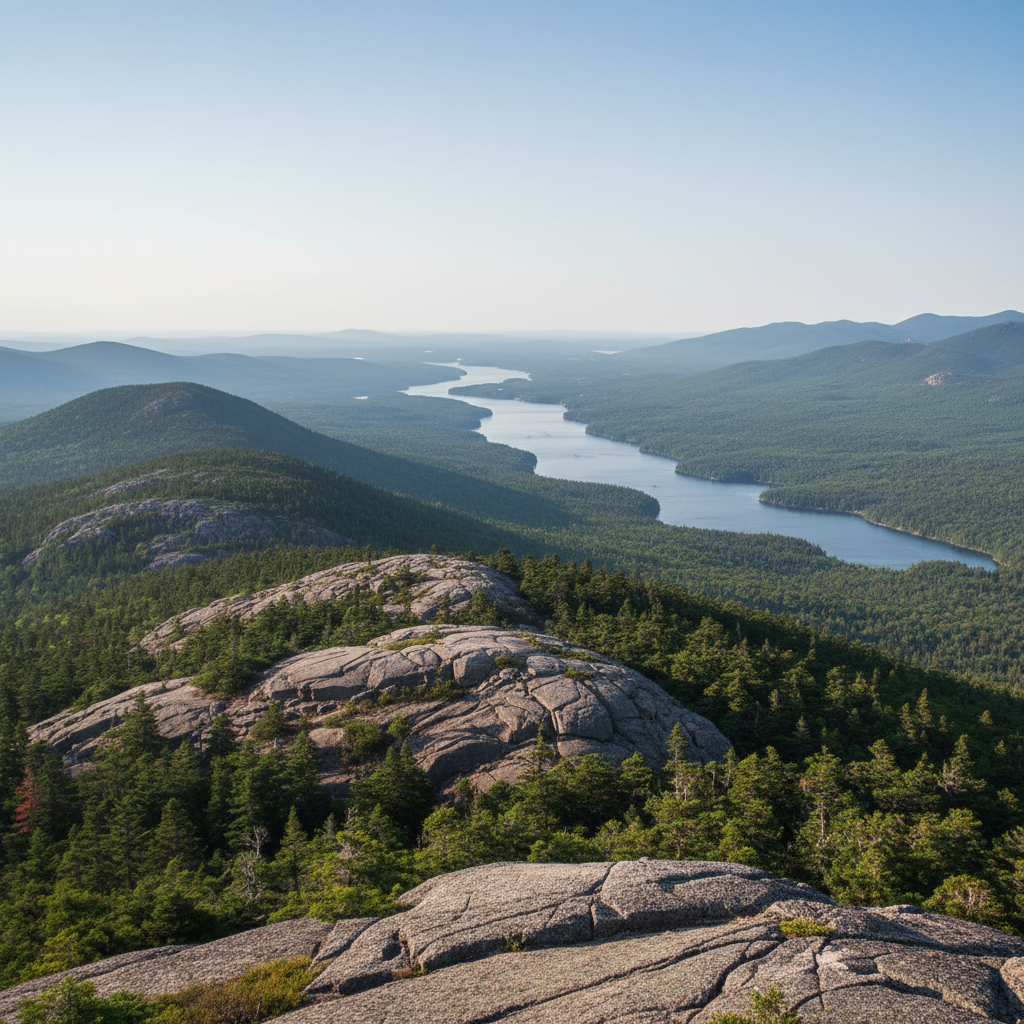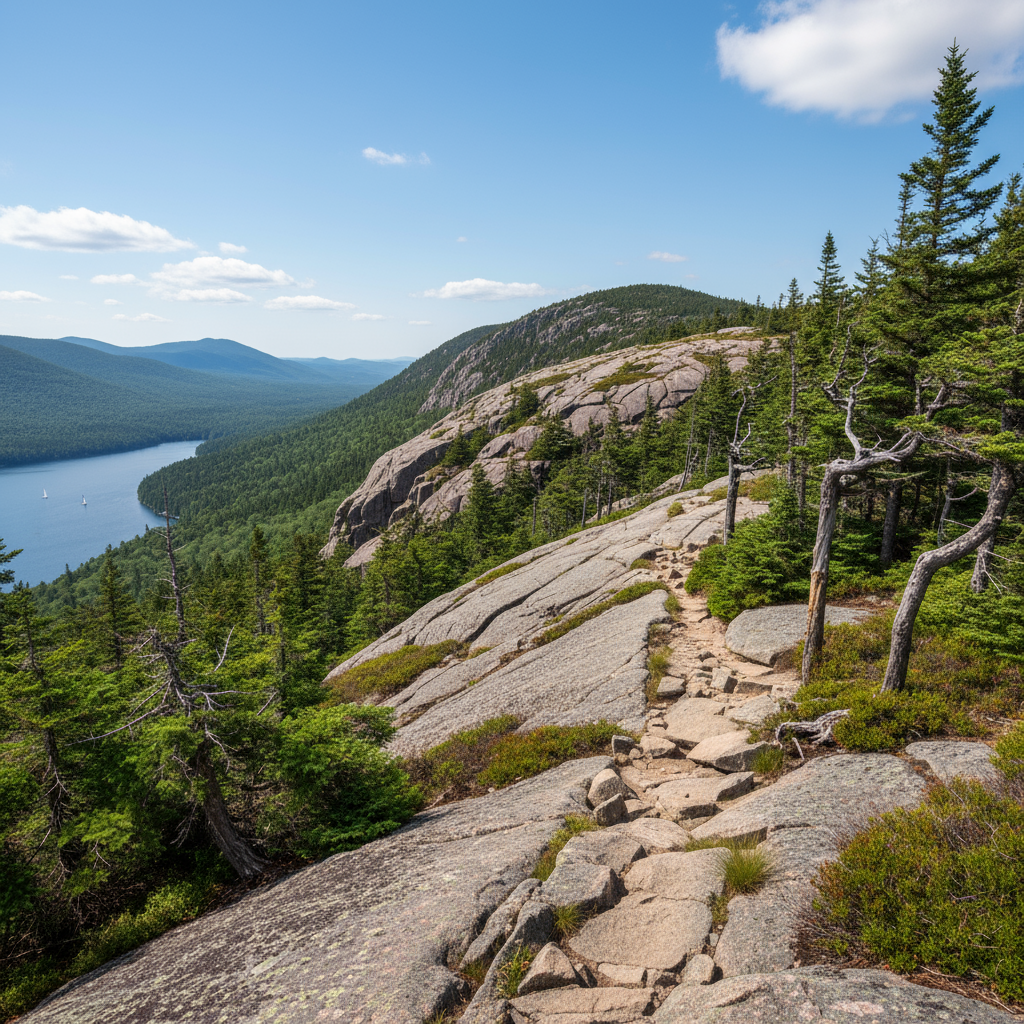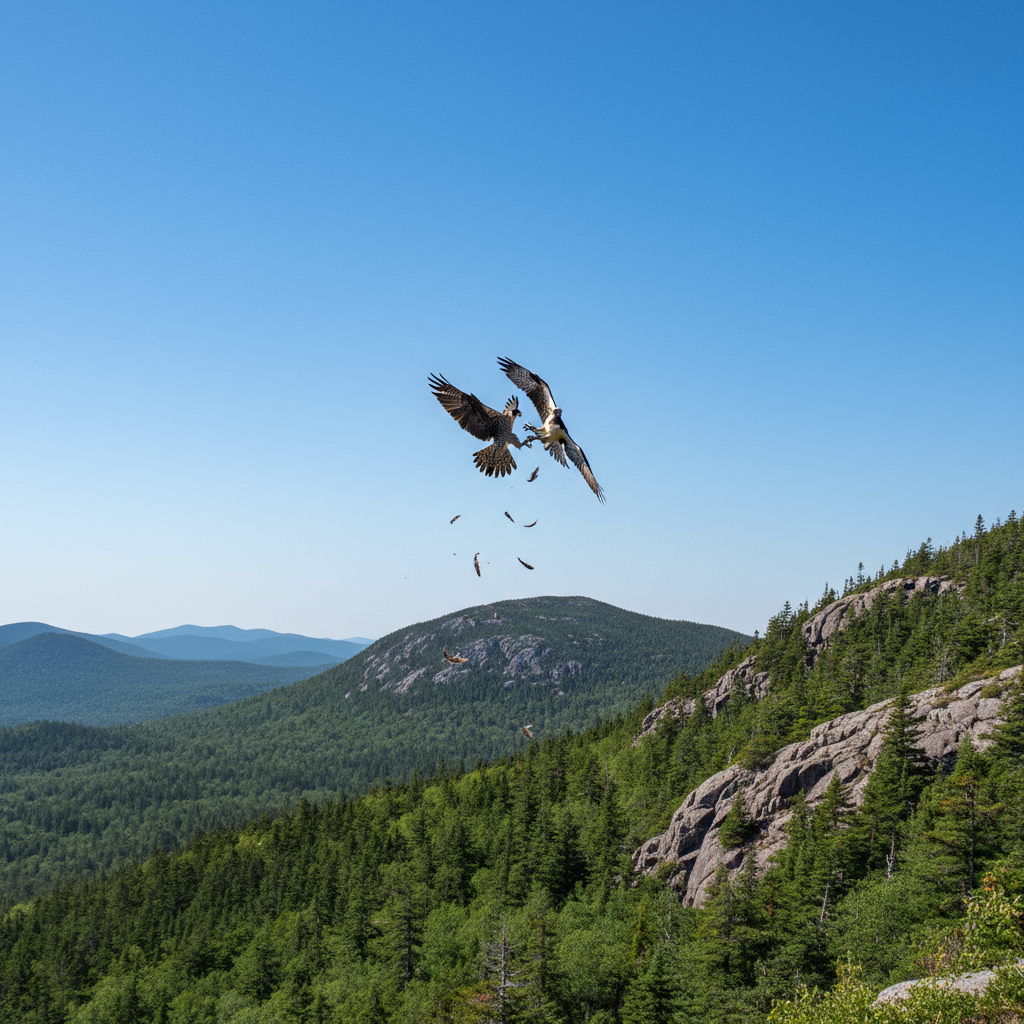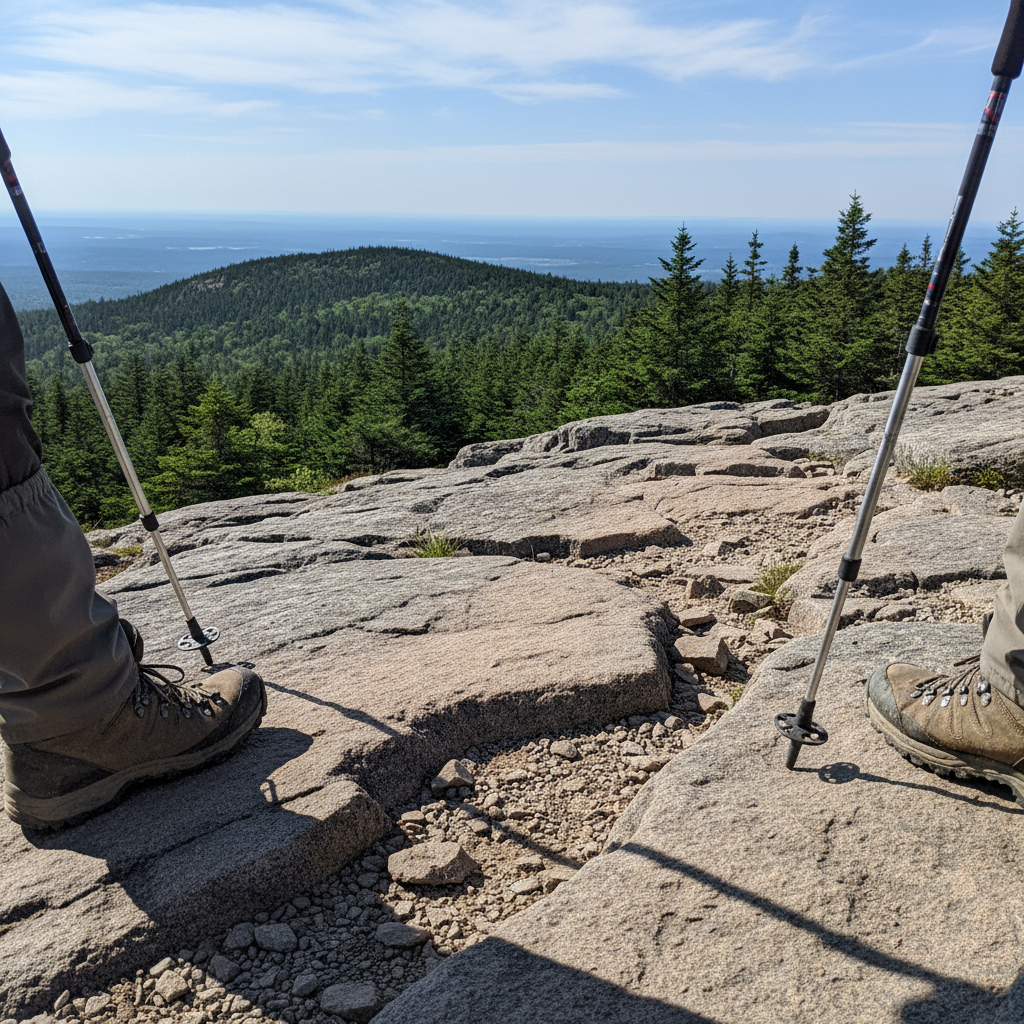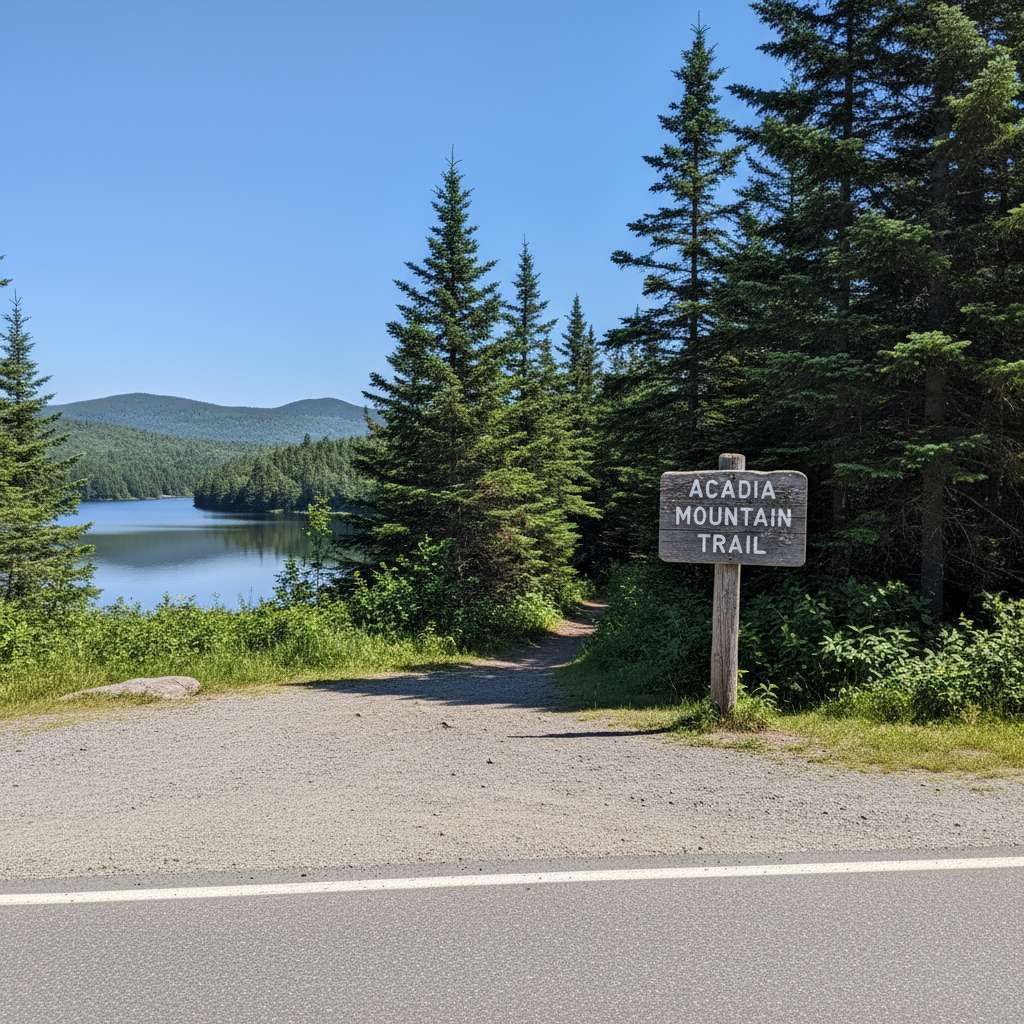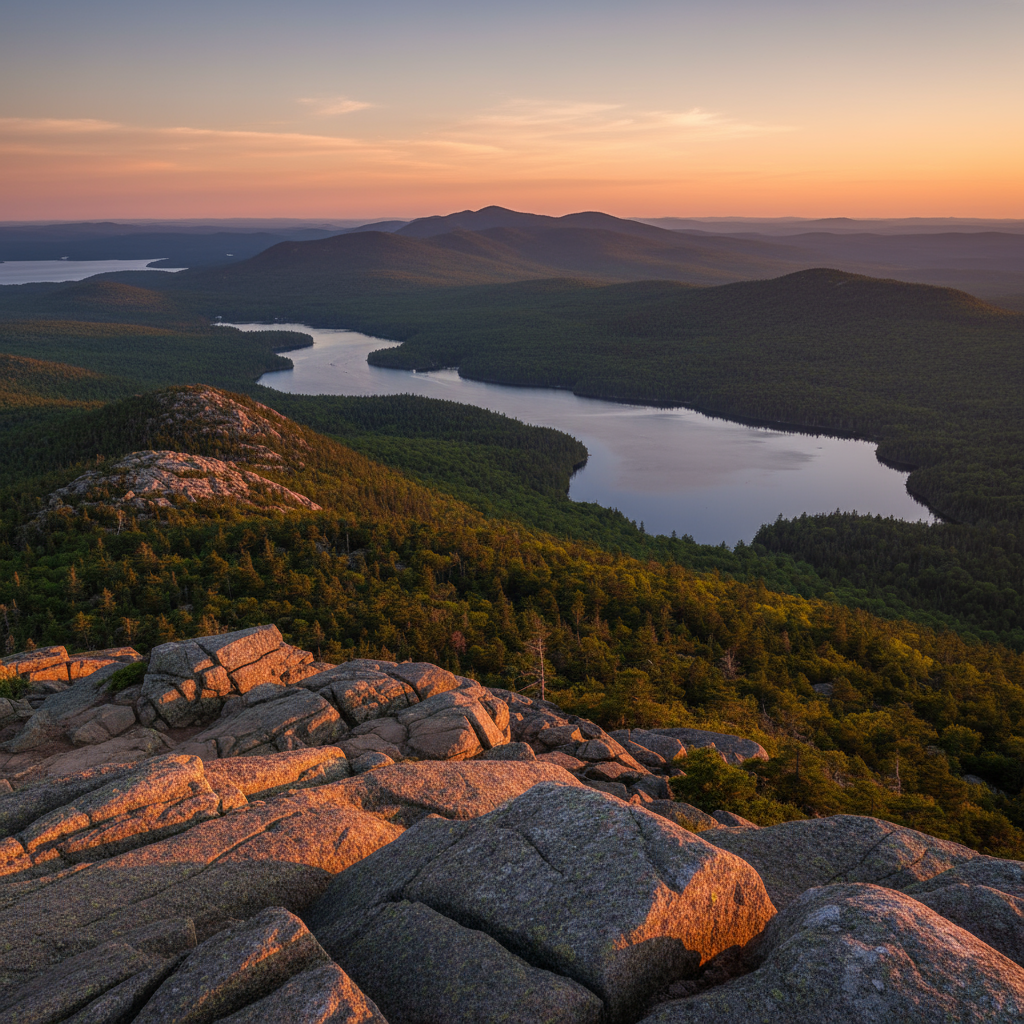Acadia Mountain in Acadia National Park
Introduction to Acadia Mountain
Acadia Mountain rises gracefully above the blue waters of Somes Sound, offering one of the most rewarding half-day adventures in Acadia National Park. Though it reaches only 681 feet in elevation, this compact peak delivers views and experiences far greater than its modest height suggests. The Acadia Mountain Trail winds through a classic mix of pine forest, granite ridges, and exposed overlooks, creating a hike that feels both wild and peaceful — the perfect introduction to the park’s western side.
What makes hiking Acadia Mountain such a favorite among visitors is its balance of accessibility and variety. The trail begins conveniently off Route 102, close to Echo Lake, and quickly climbs into terrain that showcases Acadia’s rugged coastal character. Families, casual walkers, and more seasoned adventurers all find something to enjoy here — from quiet woodland stretches to short, exhilarating scrambles that lead to panoramic views.
At the summit, hikers are rewarded with breathtaking scenery that captures Acadia’s essence. Somes Sound glimmers far below, dotted with sailboats and surrounded by evergreen slopes, while the distant Atlantic horizon completes the vista. On clear days, the light seems to shift across the water and rock, creating a scene that changes with every glance. To hike Acadia Mountain is to experience the park’s beauty distilled into one manageable trail — scenic, peaceful, and unforgettable.
Acadia Mountain Quick Facts
- Acadia Mountain location: West side of Mount Desert Island, Acadia National Park
- Acadia Mountain main trail: Acadia Mountain Trail (1.6-mile loop)
- Acadia Mountain elevation: 681 feet (208 meters)
- Acadia Mountain trailhead: Route 102 near Echo Lake
- Acadia Mountain highlights: Granite ridges, Somes Sound views, quiet forest trails
Why Hike Acadia Mountain?
Hiking Acadia Mountain is one of the best ways to experience the quieter, more intimate side of Acadia National Park. While Cadillac Mountain draws much of the attention with its sunrise views and crowds, Acadia Mountain offers something different — a sense of solitude, serenity, and wild Maine beauty without the rush. Rising to a modest 681 feet, the mountain proves that size doesn’t determine reward. The Acadia Mountain Trail blends steep scrambles, forest shade, and open granite ledges into a compact adventure that captures everything visitors love about Mount Desert Island. The moment you set foot on the path, you’re immersed in pine-scented forest, surrounded by birdsong and filtered light dancing through the canopy. As the trail climbs, it quickly gains character: short bursts of elevation, rocky sections that invite a bit of hands-on hiking, and scenic clearings where glimpses of Somes Sound peek through the trees. Those moments of reveal — blue water framed by autumn color or the glint of sunlight across Echo Lake — make the steady climb feel effortless. Each step draws you closer to one of the park’s most rewarding summits, where wide-open views unfold across ridgelines, ocean, and distant islands.
At the top, the landscape feels uniquely “Acadia.” Weathered granite ledges drop away toward the shimmering inlet below, while evergreens stand against the coastal wind. You can watch sailboats glide along Somes Sound or trace the rolling shape of the island stretching toward the horizon. It’s a view that’s both humbling and peaceful — a reminder that even smaller mountains can deliver sweeping grandeur. Many hikers linger here with a packed lunch or camera, soaking in the stillness that contrasts so beautifully with the busier eastern side of the park.
The Acadia Mountain Trail is approachable for most hikers, covering about 1.6 miles round trip, yet its mix of climbs and descents provides just enough challenge to make the summit feel earned. It’s ideal for families, photographers, or anyone looking to escape the crowds. Experienced hikers often extend their journey by linking nearby trails such as Valley Cove Trail or St. Sauveur Mountain, forming longer loops that showcase the rugged west side of Mount Desert Island.
Every season adds its own magic — bright wildflowers in spring, warm breezes and blue waters in summer, fiery Acadia fall foliage in autumn, and crisp solitude in winter. No matter when you visit, hiking Acadia Mountain offers the perfect balance of effort, beauty, and tranquility — a pure expression of what makes hiking Acadia National Park unforgettable.
Trail Treasure
- Acadia Mountain hike: A short but rewarding climb reaching 681 feet with big-sky views over Somes Sound.
- Acadia Mountain trail: Offers a balance of steep granite ridges and quiet forest paths.
- Acadia Mountain summit: Less crowded than Cadillac, giving hikers a more peaceful experience.
- Hiking Acadia Mountain: Perfect for families, first-time visitors, and seasoned hikers alike.
Acadia Mountain Trail Options
The Acadia Mountain Trail is the main route to the summit, and it’s one of the most rewarding short hikes in the entire park. At just 1.6 miles, the loop might sound easy on paper, but it combines a steady ascent, rugged granite ridges, and sweeping views that make it unforgettable. Starting from the Acadia Mountain trailhead along Route 102, the trail climbs quickly through pine forest before breaking out onto open rock ledges. From here, hikers get their first glimpses of Somes Sound and Echo Lake, reminders that this mountain sits at the heart of Mount Desert Island’s western side.
For those who want a direct experience, the classic Acadia Mountain hike simply follows the loop up one side and down the other. The ascent is steeper heading up from the east, while the descent toward the west side is a bit more gradual. Many hikers prefer to start clockwise, tackling the climb early and easing down toward the end. Others enjoy the opposite approach, choosing a gentler rise before a sharper descent. Either way, the Acadia Mountain Trail ensures variety, with alternating forest cover and open stretches of granite that give a taste of everything Acadia has to offer.
The trail also connects seamlessly to several other routes, making it easy to expand the hike into a half-day adventure. The Valley Cove Trail, which runs along Somes Sound, can be added to create a longer, more challenging circuit. Pairing Acadia Mountain with St. Sauveur Mountain, just across the road, is another popular choice. This combination delivers back-to-back summits with views that contrast dramatically: Acadia Mountain overlooking Somes Sound and the Atlantic, and St. Sauveur giving a forested inland perspective.
Because the Acadia Mountain trailhead is located right off Route 102, access is simple. Parking is limited, though, and spaces fill quickly during peak summer hours. Arriving early ensures not only a spot for your car but also quieter conditions on the trail. In busy months, hikers may even find it helpful to use the Island Explorer Shuttle, which stops nearby and allows visitors to skip the stress of parking altogether.
Seasonal conditions change the character of the Acadia Mountain Trail. In spring, meltwater can make some of the rock faces slippery, while summer brings steady traffic from families and day hikers. Fall is perhaps the most spectacular time to attempt the Acadia Mountain hike, as the ridges glow with autumn foliage and the crisp air makes climbing more comfortable. Winter hikers who are properly prepared with traction often find they have the trail to themselves, enjoying rare solitude with icy views of Somes Sound.
Whether you choose the short loop or expand the hike into a longer circuit, the Acadia Mountain Trail is flexible enough to suit nearly every visitor. From a family outing to a demanding ridge walk, it offers options that highlight the best of Acadia National Park while keeping Acadia Mountain as the central focus.
• Acadia Mountain Trail loop: 1.6-mile circuit with clockwise or counterclockwise options.
• Acadia Mountain hike choices: Steeper ascent on the east side or gentler climb from the west.
• Hiking Acadia Mountain extensions: Link to Valley Cove or St. Sauveur for longer routes.
• Acadia Mountain trailhead: Route 102 near Echo Lake with easy access to multiple loops.
Summit Views from Acadia Mountain
Reaching the summit of Acadia Mountain is one of those moments that defines a trip to Acadia National Park. Though it rises only 681 feet, the sense of elevation feels much higher — every step upward leads to bigger skies, brighter light, and broader views. From the smooth granite ledges at the top, the world opens wide: to the east, Somes Sound gleams like a ribbon of silver, and to the west, Echo Lake lies still and reflective beneath a forested ridge. For many visitors, hiking Acadia Mountain delivers more scenic payoff per mile than any other short trail in the park.
Facing east, the view of Somes Sound dominates the horizon. This deep glacial inlet, often called the only fjord on the East Coast, gives the climb its distinctive drama. Sailboats drift along its calm waters in summer, and the sunlight flickers across the waves like a living mirror. Turning south and west, the scenery shifts — forests roll down toward the lake, the Atlantic glows faintly beyond, and the ridges of Mount Desert Island seem to ripple outward in every shade of green, gray, and blue. For a mountain of its size, the Acadia Mountain Trail feels surprisingly grand, offering one of the park’s most complete panoramas in all directions.
The granite summit itself feels almost designed for lingering. Hikers often stop for a picnic or to rest on the wide, sun-warmed ledges, where the rock has been polished smooth by centuries of wind, rain, and footsteps. Because Acadia Mountain is smaller and less visited than Cadillac or Champlain, it retains an atmosphere of quiet — perfect for reflection or photography. Even during peak months, it’s common to find a private perch with nothing but the cry of gulls and the sound of wind through pine.
Each season reshapes the experience. In spring, fresh leaves tint the forest below in bright green, and waterfalls may sparkle in the distance after heavy rain. Summer brings deep blue skies and boats dotting Somes Sound. Fall transforms the scene entirely — the slopes burn with red, gold, and orange, and the crisp air sharpens every color and line. Winter, too, holds its magic: the sound freezes in silence, and the snow-dusted ridges glow under low afternoon light.
No matter the season, to hike Acadia Mountain is to see the park from its purest perspective — not from its highest point, but from one of its most beautiful. Whether you’re chasing sunrise light, watching the sailboats glide far below, or simply sitting in stillness on a granite ledge, the summit of Acadia Mountain captures everything that makes this park unforgettable.
• Acadia Mountain summit: Expansive granite ledges with panoramic views of Somes Sound and Echo Lake.
• Acadia Mountain trail scenery: Alternates between shady forest and open ridges with sweeping perspectives.
• Hiking Acadia Mountain vistas: Sailboats often dot Somes Sound in summer, adding life to the landscape.
• Acadia Mountain seasons: Golden foliage in autumn, pastel sunrises, and snow-dusted ridges in winter.
Wildlife & Nature on the Mountain
Hiking Acadia Mountain is not just a climb; it’s a journey through the living ecosystems that make Acadia National Park wildlife so remarkable. From the first steps at the Acadia Mountain trailhead near Echo Lake, you’re immersed in a world alive with movement and sound. The lower slopes wind through dense forest — a mix of spruce, pine, birch, and maple — that perfectly represents the diversity of trees in Acadia National Park. In spring and summer, the canopy hums with activity: warblers sing from high branches, chickadees flit between trunks, and the rhythmic tapping of woodpeckers echoes across the ridge. Red squirrels chatter in the distance while deer graze quietly in shaded clearings. These forested stretches remind every visitor that the wildlife in Acadia National Park is both abundant and surprisingly approachable.
As the trail climbs, the forest begins to thin and open views reveal the rocky shoulders of the mountain. Here, the landscape transforms into something uniquely rugged. Hardy shrubs like juniper and lowbush blueberry cling to cracks in the granite, while pale lichen paints delicate patterns across the stone. These hardy plants — typical of the plants of Acadia National Park — endure fierce coastal winds and shallow soil, thriving where few others can. In midsummer, ripe blueberries dot the ledges, offering a small and unexpected treat for hikers who pause to look closely.
Wildflowers bring bursts of color between the rocks. Pink lady’s slipper orchids appear in early summer, while goldenrod, aster, and yarrow brighten the late-season slopes. The vegetation may seem sparse, but these resilient species showcase how life flourishes even in harsh conditions. For a more curated look at native flora, the Wild Gardens of Acadia near Sieur de Monts display many of the same plants found along the Acadia Mountain Trail — a perfect stop for nature enthusiasts exploring the west side of the park.
Above the tree line, broad-winged hawks, eagles, and falcons often soar on thermals rising from Somes Sound. Their silhouettes glide effortlessly above the trees of Acadia National Park, scanning for movement below. The interplay of forest, granite, and ocean gives Acadia Mountain an ecological richness that belies its modest height. Each season reveals new activity — spring migrations, summer blooms, and autumn foliage blazing across the ridges.
In every sense, the Acadia Mountain hike captures the spirit of Acadia National Park wildlife: resilient, diverse, and alive with quiet beauty. It’s a trail where each step connects hikers more deeply to the natural world, making even the smallest discoveries feel unforgettable.
Wildlife & Nature Highlights on Acadia Mountain
• Acadia National Park wildlife: Spot red squirrels, chickadees, deer, and hawks along the forested slopes.
• Plants of Acadia National Park: Discover spruce, pine, juniper, and wild blueberries thriving on granite ledges.
• Wild Gardens of Acadia: See native trees and plants up close — many also found along the Acadia Mountain Trail.
• Acadia Mountain animals: White-tailed deer, foxes, and falcons are often seen from the trail and summit overlooks.
• Seasonal changes: Spring wildflowers, summer berries, and fall foliage make every hike visually unique.
Photography on Acadia Mountain
For photographers, Acadia Mountain is one of the best-kept secrets in Acadia National Park. The Acadia Mountain Trail may be short, but it delivers an incredible variety of photographic opportunities, from shaded forest paths and rugged granite ridges to sweeping views of Somes Sound and the Atlantic horizon. Because the climb is relatively quick, even casual hikers with a camera or smartphone can reach the summit and return with images that capture the very essence of the park. For those who enjoy more deliberate photography, the mountain’s varied terrain and changing light conditions provide endless possibilities.
The summit is the crown jewel for photography. From the granite ledges, visitors can frame Somes Sound stretching below, often with sailboats gliding across its surface in the warmer months. The fjard’s deep blue waters contrast beautifully with the green ridges of Mount Desert Island and the open sky above. At different times of day, the light transforms the view. In early morning, the soft pastels of sunrise illuminate the Sound, while afternoon light sharpens the textures of rock and water. Sunset brings warm, golden tones that create dramatic silhouettes of the surrounding ridges. For anyone interested in landscape photography, hiking Acadia Mountain offers a chance to capture classic Maine scenery without the heavy crowds found on Cadillac.
Along the trail itself, there are equally appealing subjects. The lower sections are shaded by pine and birch, with dappled sunlight filtering through the canopy. This creates excellent conditions for capturing forest details — moss-covered rocks, small streams, or close-up shots of wildflowers in spring. As the trail climbs higher, the vegetation thins and gives way to open ledges dotted with blueberry bushes and lichens. These natural elements provide striking foregrounds for wide-angle shots of the vistas beyond. The mix of rugged granite and delicate plant life creates a visual contrast that photographers find especially rewarding.
Wildlife can also be part of the photographic experience on Acadia Mountain. Birds, squirrels, and chipmunks are common, and in the summer months butterflies and dragonflies add splashes of movement and color. Patience is often rewarded with candid shots of animals going about their routines, set against the backdrop of the mountain’s natural beauty.
Practical tips for photography include arriving early or staying late in the day to avoid the harsh midday sun. Bringing a tripod helps with capturing low-light shots at dawn or dusk, while a polarizing filter enhances the contrast between sky and water. For smartphone photographers, the panoramic mode is ideal for the wide views from the summit. Because the Acadia Mountain trailhead is close to Route 102, it is easy to time a visit for the best light without a long approach hike.
In every season, the Acadia Mountain hike offers fresh photographic potential. Spring’s wildflowers, summer’s sailing activity on Somes Sound, autumn’s vibrant foliage, and winter’s snow-dusted ridges all provide unique perspectives. For many visitors, a single climb results in dozens of memorable images — proof that this modest peak holds some of the richest photographic rewards in the park.
Shot List: Summit to Sound
- Acadia Mountain summit photography: Wide-angle shots of Somes Sound, Echo Lake, and forested ridges.
- Acadia Mountain trail photos: Capture shaded forest paths, granite ridges, and open coastal scenery.
- Hiking Acadia Mountain images: Early morning and golden hour light create dramatic compositions.
- Acadia Mountain photography tips: Use a polarizer for sky and water contrast; panoramic mode works well.
Accessibility & Visitor Tips
The Acadia Mountain Trail is often described as “moderate,” but that label can mean different things to different hikers. The path climbs steadily from the Acadia Mountain trailhead on Route 102, with sections that are steep and rocky. Although the total distance of the loop is only 1.6 miles, hikers should expect uneven footing, exposed granite, and a few scrambles that require steady balance. Good footwear is essential. Hiking boots or sturdy trail shoes provide better grip on the granite than sandals or casual sneakers. Trekking poles can also help, especially on the steeper downhill sections where loose gravel sometimes makes footing tricky. This moderate climb is often considered the perfect Acadia National Park mountain for visitors who want a balance of challenge and scenery.
Families with older children often find this to be a perfect introduction to Acadia’s hiking scene. The Acadia Mountain hike is short enough to fit into a half-day outing, but it still delivers the sense of accomplishment that comes from reaching a summit. Parents should be prepared to supervise closely on the ledges, as there are drop-offs near the summit. While not as intimidating as the Beehive or Precipice, Acadia Mountain still requires attention and caution. For younger hikers, it is wise to take frequent breaks, enjoy the forest sections, and use the experience as a chance to introduce trail etiquette.
Parking is limited at the Acadia Mountain trailhead, which sits just south of Echo Lake. The lot has only a handful of spaces, and it fills quickly on summer mornings. Arriving early is the best way to secure a spot and enjoy a quieter climb. If parking is full, consider using the Island Explorer Shuttle, which stops nearby during the summer months. This option is not only convenient but also reduces traffic congestion on Route 102. Because the hike is relatively short, many visitors pair it with a swim at Echo Lake or another nearby hike to make a full day of exploration.
Seasonal conditions play a major role in accessibility. In spring, wet rock can be slippery, particularly after rain. Summer brings more hikers, which can make the trail feel busier, though it rarely approaches the crowds found on Cadillac Mountain. Fall is a favorite time for many, as cooler temperatures make the climb more comfortable and the foliage adds color to every view. Winter hiking is possible but only for those with proper equipment, such as microspikes for traction and warm clothing. The granite ledges can be icy, and the short trail can feel much longer in cold, windy conditions.
To make the most of your Acadia Mountain hike, plan ahead. Carry water, snacks, and a light jacket, as coastal weather can change quickly. Allow extra time at the summit to enjoy the scenery, and be ready to adjust your pace based on conditions. With preparation and care, this short but rewarding hike offers one of the most memorable adventures in Acadia National Park.
Hike Smart
- Acadia Mountain trail difficulty: A moderate loop with rocky footing, short scrambles, and ledges.
- Hiking Acadia Mountain tips: Wear sturdy shoes, carry water, and supervise children near drop-offs.
- Acadia Mountain trailhead parking: Limited spaces on Route 102 — arrive early or use the Island Explorer Shuttle.
- Acadia Mountain hike safety: Seasonal conditions vary — expect slippery rock in spring and icy ledges in winter.
Getting to Acadia Mountain
Finding your way to Acadia Mountain is straightforward, but a little planning makes the experience smoother. The starting point is the Acadia Mountain trailhead, located along Route 102 on the western side of Mount Desert Island. This road passes through the quieter “back side” of Acadia National Park, away from the heavy traffic of the Park Loop Road and Cadillac Mountain. The trailhead itself is just south of Echo Lake, making it easy to combine a hike with a swim or picnic at the lake afterward.
The parking lot at the trailhead is small, with only a limited number of spaces. During peak summer mornings, it often fills up quickly. Many hikers arrive early not just to secure parking but also to enjoy the cooler air and quieter conditions before mid-day crowds arrive. If you reach the area and the lot is full, an excellent alternative is to use the Island Explorer Shuttle. This free, seasonal bus service stops near the trailhead and allows visitors to avoid the stress of searching for parking along busy Route 102. The shuttle is especially convenient for families or groups, as it removes the need for multiple vehicles.
Once you arrive, the trailhead is clearly marked, with signs pointing toward the Acadia Mountain Trail loop. From here, the path climbs into the woods almost immediately. Because the Acadia Mountain hike is a loop, you have the option of hiking clockwise or counterclockwise. Starting clockwise means tackling the steep ascent first, reaching the summit quickly, and descending more gradually on the western side. Hiking counterclockwise provides a more gradual climb but a steeper descent. Both options lead to the same granite summit, so it really comes down to personal preference.
Getting to Acadia Mountain is also about timing. Each season brings a slightly different character to the hike. In spring, the forest around the trailhead is filled with fresh greenery, though wet conditions may make the rocks slippery. Summer is the busiest season, with cars lining Route 102 and more people on the Acadia Mountain Trail, but the payoff is lively views of Somes Sound dotted with sailboats. Fall brings cooler air and vibrant foliage, creating some of the most photogenic conditions for hiking Acadia Mountain. Winter access is still possible for prepared hikers, though snow and ice mean fewer visitors and more solitude.
Because the trailhead is so close to Echo Lake, many hikers pair their Acadia Mountain adventure with a swim or a picnic. Others combine it with nearby hikes like St. Sauveur Mountain or the Valley Cove Trail. The ease of access, variety of options, and the clear signage make getting to Acadia Mountain simple for first-time visitors and repeat hikers alike. Whether you drive directly to the lot, catch the shuttle, or arrive early to beat the rush, reaching the trailhead is the first step toward one of the most rewarding hikes in Acadia National Park. Many visitors combine this trail with St. Sauveur or Valley Cove, creating a loop that showcases another rewarding mountain Acadia National Park adventure.
Finding the Trail
- Acadia Mountain trailhead: Located on Route 102, just south of Echo Lake on Mount Desert Island.
- Acadia Mountain access: Trailhead signage clearly marks the start of the Acadia Mountain Trail loop.
- Hiking Acadia Mountain transport: Use the Island Explorer Shuttle in summer to avoid parking stress.
- Acadia Mountain hike start: Choose clockwise for a steep climb first, or counterclockwise for a gradual ascent.
Wrapping Up Your Acadia Mountain Visit
Acadia Mountain may not boast the height or fame of Cadillac, but it embodies much of what makes Acadia National Park special. From the moment you set out on the Acadia Mountain Trail, the climb offers a mix of quiet forest, rugged granite ridges, and the promise of sweeping coastal views. The summit itself is the reward — a broad ledge overlooking Somes Sound, Echo Lake, and the ridges of Mount Desert Island. For many hikers, this smaller peak feels more personal and more peaceful than the park’s better-known mountains.
The convenience of the Acadia Mountain trailhead, located just off Route 102, makes the hike easy to fit into any visit. Whether you choose the short loop, combine it with other trails, or simply sit at the top to enjoy the views, Acadia Mountain delivers a sense of accomplishment without demanding an all-day effort. It’s the kind of hike that leaves visitors wanting to return, not because it was unfinished, but because it was so rewarding.
For anyone looking to balance accessibility with authentic scenery, hiking Acadia Mountain is an experience worth repeating.
Farewell from Acadia Mountain
Thanks for hiking Acadia Mountain with us—granite ridges, Somes Sound views, and quiet forest trails. Ready to explore more mountains in Acadia and discover even more hidden trails?
Explore Acadia National Park mountainsUseful Links for Your Hike
Get More Acadia Mountain Tips
Love the views from Acadia Mountain? Don’t miss insider trail guides, summit photo ideas, and seasonal updates for hiking Acadia Mountain—delivered straight to your inbox.
Sign Up
